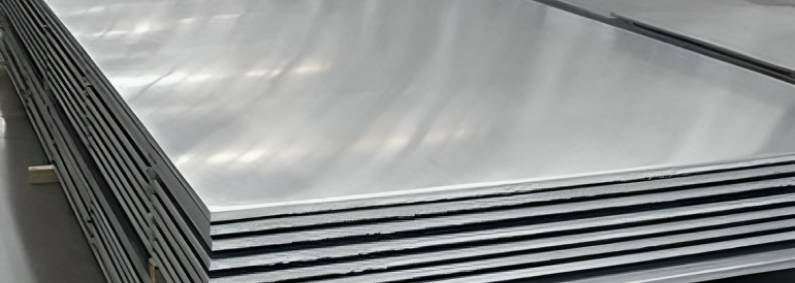Stainless Steel 321 GR, 310 GR Sheets

Stainless Steel 321 and 310 grade sheets are high-performance austenitic stainless steel alloys, renowned for their excellent corrosion resistance, high-temperature stability, and superior mechanical properties. These grades are specifically designed for demanding applications across industries such as aerospace, petrochemical, chemical processing, and heat treatment.
Stainless Steel 321 Grade Sheets
Stainless Steel 321 is stabilized with titanium, making it highly resistant to intergranular corrosion, especially in environments with high temperatures. This grade is ideal for applications that involve welding and high-temperature exposure.
Key Features of Stainless Steel 321
- High Resistance to Oxidation: Performs well in continuous service up to 925°C (1700°F).
- Corrosion Resistance: Excellent resistance to intergranular corrosion after exposure to high temperatures.
- Stabilization: Titanium stabilization prevents chromium carbide precipitation during welding.
- Good Formability: Easily fabricated and machined for complex designs.
- Weldability: Suitable for all standard welding methods.
Applications of Stainless Steel 321 Sheets
- Aerospace components
- Chemical processing equipment
- Exhaust manifolds
- Heat exchangers
- Thermal oxidizers
- Food processing equipment
Chemical Composition of Stainless Steel 321
| Element | Percentage |
|---|---|
| Chromium (Cr) | 17.0-19.0 |
| Nickel (Ni) | 9.0-12.0 |
| Titanium (Ti) | 5 x (C+N) - 0.7 |
| Carbon (C) | 0.08 (maximum) |
| Manganese (Mn) | 2.0 (maximum) |
| Silicon (Si) | 1.0 (maximum) |
| Phosphorus (P) | 0.045 (maximum) |
| Sulfur (S) | 0.03 (maximum) |
Stainless Steel 310 Grade Sheets
Stainless Steel 310 is a high-alloyed austenitic stainless steel that offers exceptional high-temperature oxidation resistance and superior strength, making it suitable for extreme environments.
Key Features of Stainless Steel 310
- High-Temperature Strength: Maintains mechanical integrity up to 1100°C (2012°F).
- Oxidation Resistance: Excellent performance in cyclic environments with temperatures exceeding 1000°C.
- Corrosion Resistance: Resists carburizing and reducing environments.
- Durability: Withstands thermal cycling and high-stress applications.
Applications of Stainless Steel 310 Sheets
- Furnace parts
- Kiln liners
- Heat treatment equipment
- Power generation components
- Petrochemical refineries
- Cryogenic structures
Chemical Composition of Stainless Steel 310
| Element | Percentage |
|---|---|
| Chromium (Cr) | 24.0-26.0 |
| Nickel (Ni) | 19.0-22.0 |
| Carbon (C) | 0.25 (maximum) |
| Manganese (Mn) | 2.0 (maximum) |
| Silicon (Si) | 1.5 (maximum) |
| Phosphorus (P) | 0.045 (maximum) |
| Sulfur (S) | 0.03 (maximum) |
Mechanical Properties
| Property | SS 321 | SS 310 |
|---|---|---|
| Tensile Strength (MPa) | 515 (minimum) | 515 (minimum) |
| Yield Strength (MPa) | 205 (minimum) | 205 (minimum) |
| Elongation (%) | 40 | 40 |
| Hardness (HRB) | 95 (maximum) | 95 (maximum) |
Available Forms
- Sheets: Thin, flat sections for structural and fabrication applications.
- Plates: Heavier and thicker sections for industrial-grade applications.
- Coils: Flexible sheets rolled for storage and transportation.
- Custom Cut Sizes: Tailored dimensions to meet specific project requirements.
Manufacturing Standards
- ASTM A240: Standard for Chromium and Chromium-Nickel Stainless Steel Plate, Sheet, and Strip.
- ASME SA240: Pressure vessel-grade stainless steel specifications.
- EN 10088-2: European standard for stainless steel flat products.
FAQs
SS 321 is stabilized with titanium, making it ideal for welding and high-temperature corrosion resistance. SS 310, on the other hand, offers superior oxidation resistance and strength at even higher temperatures.
Yes, both grades can be welded using standard welding techniques. SS 321 requires no post-weld heat treatment, while SS 310 may need controlled heat input for optimal performance.
SS 321 is commonly used in aerospace, food processing, and chemical equipment. SS 310 is preferred for furnace parts, kilns, and petrochemical applications due to its high-temperature stability.

Products
Industry We Serve
- Oil & Gas industries
- Chemical process industries
- Pump and valve in high pressure component
- Food industries
- Pulp and paper industry
- Aerospace industry
- Power plant
- Mechanical component
- Sugar industry
- Cement industry
